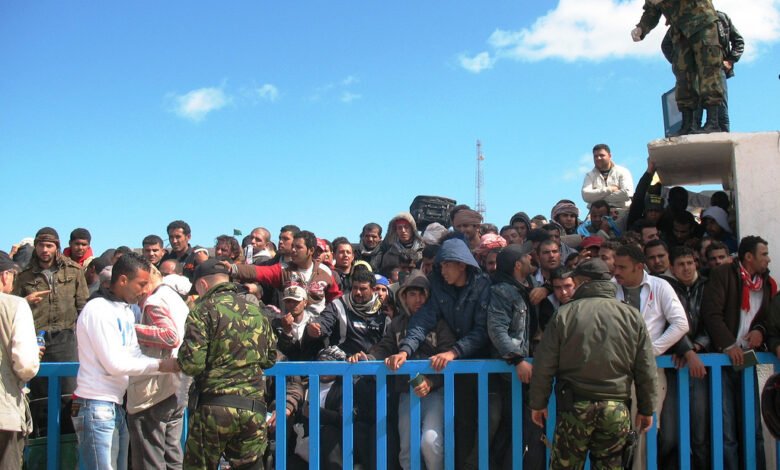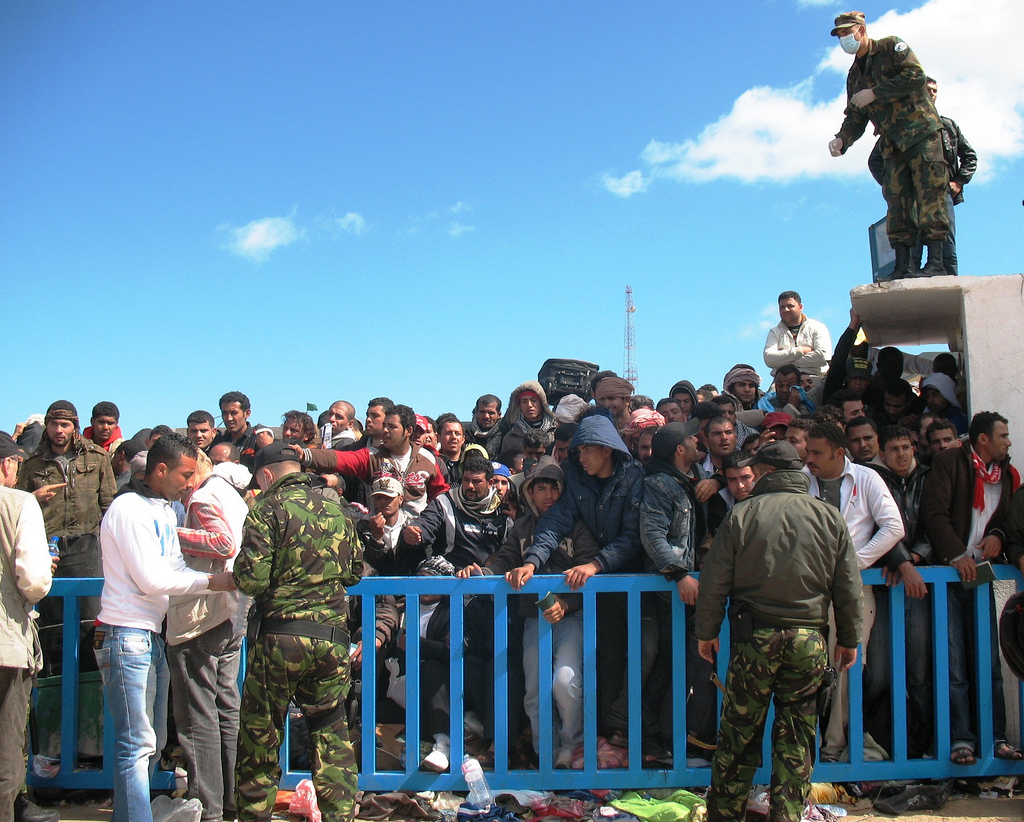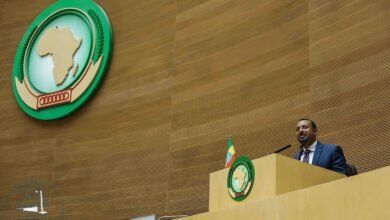
‘They are arresting migrants sleeping near the bus station! We must urgently reach out to as many undocumented individuals as possible and advise them to avoid the city centre – it’s become too dangerous again.’ It was 17 September when two of my research partners delivered this disheartening news: yet another police raid had resulted in the disappearance of at least 40 Black migrants, squatting a building under construction in front of the Zarzis terminal, who had been patiently waiting to purchase tickets to Sfax and, from there, potentially reach Europe.
The presence of these migrants, who had journeyed on foot from the Libyan and Algerian borders and sought refuge in disused buildings, was conspicuous when I was there in early September. However, soon afterwards, they had vanished. Rumours spread among local citizens and those migrants who had managed to evade the police about a new wave of arrests and deportations of Black non-nationals over the south-eastern and south-western borders.
Prior to this, I had been under the illusion that the harrowing cycle of illegal state deportations, acting as death sentences to racialized migrants, which had plagued Southeast Tunisian throughout July, had come to an end. These events shattered that hope and underscored the unwavering policy of Tunisian authorities to expel Black migrants.
A few days later, the European Commission made headlines, announcing the transfer of 127 million euros in financial aid as a first instalment to the Tunisian government within the scope of the Memorandum of Understanding (MoU) for a strategic and far-reaching partnership signed on 16 July 2023. This move exemplified the EU’s active support of what El Miri describes as the institutional, social and physical racialization of ‘sub-Saharan migrants’ throughout their migratory path, from which arises what Mbembe coined as the necropolitics of contemporary global borders, concealed under the guise of combatting irregularized migration.
While I write these lines, the words of Mourad, the head of a socio-cultural association in Medenine, echo in my mind: ‘Ever wondered what the average Tunisian is saying on the streets these days?’ In mid-September he had welcomed me for over an hour in the front office where his association supports both vulnerable Tunisians and irregularized migrants in a small village of the south-eastern governorate of Medenine. After I explained my research goal – to engage local stakeholders in exploring the impact of evolving border controls on the economic and social lives of those living, crossing or stranded along the Tunisian-Libyan border – he chose to dispense with formalities and sat beside me. Together, we retraced the dramatic developments of last July when, after weeks of tensions and protests across the governorate of Sfax, a street brawl between a Tunisian and a group of Black migrants led to the former’s death, triggering self-created squads of citizens to launch a veritable ‘Black hunt’. Forced evictions of Black migrants from their homes and civilians conducting extrajudicial arrests of racially profiled non-Tunisians across the city followed.

Libyan-Tunisian border, 2011. Image by EU Civil Protection and Humanitarian Aid, via Flickr.
Instead of curbing this public-initiated racist organized violence, national security authorities opted for rapid mass deportations, expelling over 1,200 Black migrants to Tunisia’s borders with Libya between 5 July and 10 July. Soon afterwards, in an attempt not to jeopardize its ongoing negotiation for EU financial support, the government partially readmitted most of those deported back to Tunisia and transferred them to reception centres operated by the International Organization for Migration (IOM) and the United Nations High Commissioner for Refugees (UNHCR) in the border governorates of Medenine and Tataouine. School dorms and abandoned warehouses were also turned into temporary shelters managed under state mandate by the Tunisian Red Crescent, whilst public authorities prevented migrants from moving further north. In the meantime, the Tunisian National Guard instructed public transport workers to act as security officials, tasked with checking the validity of travel documents – tantamount to scrutinizing suspected undocumented migrants on the basis of their skin colour.
Research partners, who intervened to support those being readmitted on 10 July, reported hundreds of individuals – children, youth and adults, male and female – dehydrated, with extreme sunstroke and sunburn, often displaying clear signs of having been beaten, their wounds untreated, suffering from high levels of psychological distress due to violence and humiliation suffered both in Sfax and at the border. And yet, for over a month, Tunisian state authorities committed over 300 more migrants to their deaths; not readmitted, they were de facto trapped on the desert fringe between Tunisia and Libya under the scorching July sun, with temperatures that rarely dipped below 40°C and even reached 50°C. It wasn’t until 10 August that Libyan and Tunisian authorities agreed to equally redistribute survivors between the two countries. This thug-of-war claimed the lives of at least 27 people.
Many interview partners I met between July and September explained how communities inhabiting the governorate of Medenine were facing a new level of state violence at the Tunisian-Libyan border zone. Albeit disproportionately targeting Black migrants, the militarization of the governorate also increased the sense of insecurity among local citizens. As Houda Mzioudet observes, this is even truer for Black Tunisians who ‘have become the collateral damage of this openly racist campaign that criminalizes an already fragile population in the context of political, social, and economic turmoil since Saied’s self-coup in July 2021.’
Members of the associative fabric active in Zarzis, Medenine and Djerba emphasized how unpredictable, ruthless and overtly racist state policies are the source of the local population’s insecurity rather than an increased Black migrant presence. Leading intergovernmental organizations, entrusted with safeguarding refugee and migrant rights, refrain from overtly criticizing President Kais Saied’s government, however. And the EU continues courting the same violent and illiberal government that sent migrants to die in the desert with its renewed and reinforced partnership for development and migration. The message was effectively communicated to Tunisian authorities that EU financial support would be conditional on curbing irregularized migration towards Europe. And yet, according to Mourad, most Tunisian citizens understood the government’s decision to sign the MoU as the umpteenth instrumental yielding to European blackmail rather than the prelude to a veritable sealing of the frontier.
In fact, except for the week that immediately followed the Rome Conference on Development and Migration on 23 July 2023, the first two weeks of August signalled a new and sharp increase in people arriving from Tunisia to Italy.
Unprecedented numbers?
The images of nearly 7,000 new arrivals documented in Lampedusa between 11 and 12 September compelled international public opinion to acknowledge a phenomenon that official statistics had been tracking since early 2023: Tunisian citizens are no longer the vast majority of those seeking ways out of Tunisia. The number of irregularized Black migrants attempting to and succeeding in reaching Europe via the Central Mediterranean from Tunisian shores has also surged. Tunisians now rank third among nationalities arriving in Italy, trailing behind citizens of the Ivory Coast and all the more behind Guinean nationals. Their number (12,168 individuals) has decreased compared to the figures recorded during the same period in both 2021 (12,511 individuals) and 2022 (14,036 individuals), when Tunisians held the top spot.
Yet, the sheer volume of arrivals can only be portrayed as a significant departure from recent Italian history when compared to data recorded since 2019. It is not by chance that rapid and overwhelming overcrowding – first at the Contrada Imbriacola hotspot and then across the entirety of Lampedusa Island – conjured memories of the so-called 2010 ‘North Africa emergency’. Much like the Meloni government now, Berlusconi’s government then consciously refrained from organizing sea search and rescue operations through institutional coordination, a move that would have facilitated the harmonization of arrivals with the effective functioning of the very first reception and asylum systems.
In both instances, governmental choices not to address the ongoing phenomenon served to portray the dynamics of mobility in the Central Mediterranean as an invasion. Conversely, between 2015 and 2017, despite registering arrivals comparable to those we are seeing today, Italian authorities took a different approach. Responding to increasing EU pressure, they coordinated procedures involving all national and international, and governmental and non-governmental actors through the implementation of protocols, which embedded the intricate framework of sea rescue with the early registration of new arrivals. This modus operandi, which constituted the Italian declination of the EU’s Hotspot Approach, facilitated the redistribution of new arrivals throughout the peninsula to prevent the country’s first reception system from collapsing.
Such a more organized regime of (im)mobility did not prevent but rather concealed the systemic violations of fundamental rights ingrained within the hotspot system. However, it did initially lead to a decrease in the number of deaths at sea by ensuring well-coordinated Search and Rescue (SAR) operations across the expanse of the Central Mediterranean. This practice then came to an abrupt halt in 2018 with Matteo Salvini’s infamous ‘security decrees’. The so-called ‘closed ports policy’, with the suspension of institutional SAR activities at sea, led to a sharp decline in arrivals, deriving from an increase in sea fatalities that public discourse consistently swept under the carpet.
Governmental authorities leveraged the widespread perception that fewer people were attempting transit as a pretext for systematically withdrawing funding from the Italian reception and asylum system, resulting in its ultimate erosion. The hermetic closure of international borders during the COVID-19 outbreak did the rest. These evolutions set the stage for the current mishandling of new arrivals, which is the real reason behind the country’s system overload. Despite this overt absence, since the declaration of the State of Emergency in April 2023, Meloni’s government has resurrected the spectre of a migrant invasion of Italy, leveraging it both to the EU and North African diplomats. The action plan in 10 points, announced by Ursula von Der Leyen on 19 September, responded to this fabricated emergency, while ignoring the European Parliament’s Committee on Foreign Affairs from 31 August, which questioned the MoU’s effectiveness. Parliament also expressed concerns that the agreement between the EU and Tunisia, as concluded by the EU Commission Directorate General for Neighbourhood and Enlargement Negotiations (DG NEAR), violates the code of EU decision-making practices and does not take the Tunisian government’s human rights violations against migrants with all due gravity, as condemned by international public opinion. And yet, Von der Leyen’s action plan reaffirmed the bid to accelerate the memorandum’s implementation and make it a model for similar agreements with other North African countries.
Manufacturing a migration crisis
Seen from the Tunisian-Libyan border, such EU policy choices are doomed to failure because they disregard the fact that unrelenting departures from Tunisia are not due to an unprecedented border control crisis. Rather they are the result of an equally manufactured migration crisis concocted by President Saied for both political and international consumption, and in total contempt of the rights and even the lives of racialized and illegalized migrant people.
According to all my interlocutors, Saied’s speech on 21 February 2023, which launched urgent measures to combat the irregular migration of ‘sub-Saharan African nationals’, constitutes a turning point in this fabrication. International media received his allegations of an international criminal plan ‘aiming to alter Tunisia’s demographic composition’ with surprise, despite his words recalling precedents from far-right political leaders of so-called European democracies. And yet, the Tunisian NGO Forum Tunisien pour les Droits Économiques et Sociaux (FTDES) underlined how worrying signals pointing to such a violent political turn in Tunisian migration management had already emerged during the previous year.
For instance, on 22 December 2022, Najla Bouden – the former Chief of Government whose designation was internationally celebrated as the first example of a female prime minister in the Arab world – suddenly decided to expel a group of Black migrants who had occupied a youth centre in La Marsa, a northern suburb of Tunis, for five years. And this, although state authorities had transferred these persons there in 2017: without offering them any other viable solution or form of regularization in the country; after militarily evacuating the Shousha refugee camp that had been created in 2011 to accommodate people escaping conflict in Libya.
Moreover, in January 2023, the Tunisian Nationalist Party launched an openly racist campaign targeting undocumented migrants ‘from sub-Saharan countries’ through compliant media and on social media. They leveraged the widespread racism ingrained in the Tunisian national imaginary and in the African continent’s social life more broadly based on a centuries-long history of the slave trade, alongside past and present forms of unfreedom, succeeding in spreading fake news that demonized Black migrants. In parallel, they started circulating a petition demanding not only the expulsion of irregularized migrants but also the imposition of visa requirements on currently exempted ‘sub-Saharan’ states, and the repeal of organic law no. 2018-50 of 23 October 2018, relating to the fight against racial discrimination.
On 17 February Tunisian security forces launched an arrest campaign with the eloquent title of ‘Strengthening the security apparatus and reducing the phenomenon of irregular residence in Tunisia’, which led to the arrest and systematic imprisonment of more than 300 people within a few days. Law enforcement conducted profiling of potential irregular residents based on phenotypical criteria (essentially skin colour), targeting minors and students regularly residing in Tunisia. Saied’s February statement, therefore, did not come out of nowhere, even though it undoubtedly precipitated the poor conditions for racialized non-nationals in the country.
Ever since, presidential policies and discourses have made Tunisia an unliveable country for irregular(ized) migrants. As the head of a well-known intergovernmental organization’s southern Tunisian office resignedly explains:
Contrary to what was the case until last year, migrants who register with our organization are only asking for transitional assistance, they no longer seek protection here’ … ‘but are trying to reach Sfax immediately to embark for Europe, despite the problems and violence there.
Confronting the Tunisian war on migration
According to Mourad, ‘hate speech has become the official discourse’ in Tunisia, targeting not only unwanted Black migrants but also the country’s civil society. ‘All the associations who did not submit to become “the docile children” of the new regime’, continues Mourad, ‘went from being considered “the heralds of democracy and revolution” to being accused of acting as “the beachhead of foreign interests” and “traitors to the homeland.”’ Shortly after dissolving parliament on 25 July 2021, Saied’s attempted to amend Decree Law no. 2011-88 on the organization of Tunisian associations, envisioning stricter Ministry of the Interior control over the country’s civil society. Resistance from the local public and the international community led to the amendment’s approval being postponed. And yet, the spectre of this revision has been hovering ever since, especially after the passing of Decree-Law no. 2022-54 almost one year later, which threatens freedom of expression under the pretext of countering the spread of fake news and cybercrime.
The apparent public success of the government’s anti-migrant campaigns, therefore, cannot be fully understood if not in conjunction with the parallel security campaigns that increasingly target political opponents, union leaders, journalists and even judges on the suspicion of assaulting state security and plotting to subvert political power. The active building of an ‘external enemy’ has gone hand in hand with the creation of an ‘internal enemy’ constituted by extra-parliamentary opposition to the president. Both magnifying migration management as a domestic and diplomatic concern, and portraying political opponents and actors of civil society as corrupt, selling out to foreign agendas and being enemies of the Tunisian people, have served Tunisian authorities’ attempts to distract public opinion from a galloping economic crisis.
Scholars and activists had uncovered Tunisian social racism in the early 2000s, which was increasingly discussed in the public sphere and on a political level after the revolution. Still, Saied’s February declaration triggered spontaneous anti-Black pogroms across the country, especially in large cities such as Tunis and Sfax. As Mourad puts it, ‘it forced Tunisians in front of a mirror that reflected the image of a racist society’. And yet, what Amnesty International recently denounced as Tunisian authorities’ ‘abusive resorting to preventive detention to reduce any forms of political opposition to silence’ succeeded in discouraging ordinary citizens from contravening increasingly violent and blatantly racist government initiatives. The 2015 Nobel Peace Prize winning Tunisian civil society organization, which had lobbied to pass ground-breaking legislation against racial discrimination in 2018, was facing arrests and imprisonment without the international community lifting a finger. What hope could ordinary citizens have of opposing such political manoeuvres?
Even though grassroots efforts emerged, forming the ‘anti-fascist front’ against racism, the perceived risk of being arrested pushed most Tunisians who were informally employing or accommodating undocumented Black migrants to dismiss and evict them en masse. This resulted in further exposing these migrants to state violence and condoned civilian attacks, without triggering strong condemnation from international humanitarian organizations such as UNHCR and IOM.
If anti-Black racism was being studied and denounced as constitutive of Tunisian society and national imaginaries already from the mid-2000s, this year it became apparent that, as El Miri’s work demonstrated for the Euro-African regime of mobility more largely, racism actively produces Tunisian migration policies too rather than the other way round.
Indeed, as Saied leveraged social racism to institutionally enforce the systematic expulsion and/or elimination of Black migrants from public spaces, Tunisia rapidly turned from being a country of refuge or better opportunities to being a country to flee from for irregularized Black migrants. Mali, Gabon, the Ivory Coast and Guinea provided airlifts to repatriate their citizens, while requests for embassy-assisted returns from Tunisia soared. People demanding to leave the country through UNHCR resettlement or evacuation schemes and through IOM Assisted Voluntary Returns started camping outside both organizations’ headquarters.
Ultimately, state violence triggered the dramatic surge in people resorting to irregular(ized) Mediterranean crossings from Tunisia to Italy much more than Tunisia’s incapacity to seal its borders. In fact, according to data aggregated by FTDES, Tunisian authorities succeeded in intercepting 39,568 people attempting crossings in the first nine months of 2023. Most of these seizures occurred between February and April, with March registering peak interceptions, right after President Saied’s February declaration. Overall, 958 of the 2,079 deaths and disappearances at sea registered in 2023 across the Central Mediterranean route were recorded near Tunisian coasts and in the country’s territorial waters, with April signalling the peak.
Tunisian authority interceptions only plummeted in correspondence with the intensification of EU-Tunisian negotiations, probably to provide the government with an effective bargaining tool. The Tunisian Ministry of Interior even refrained from publishing official data on interceptions for July, suggesting yet another dramatic deterioration in conditions for irregular(ized) and racialized migrants.
Open border solutions
The events that have unfolded in the country since February demonstrate that, regardless of European pressure, the Tunisian government needs open not hermetically sealed borders. It aims not so much to prevent irregular(ized) migrants from reaching Europe but rather to push them to leave Tunisia.
The promised 150 million euros from Brussels under the MoU won’t be nearly enough to lift Tunisia’s struggling economy, as the sum won’t even suffice to properly structure the reception and return mechanisms the country would need to seriously provide more systematic sea interceptions and border controls. When we met at the beginning of September, the local representative of an international organization actively involved in the issue bitterly observed:
Time and energies were lost in preparing the new Memorandum of Understandings. … There is a lack of planning concerning whatever will await intercepted undocumented migrants after their disembarkation. These people no longer want to stay in Tunisia, and they refuse to voluntarily go back to their countries. Meanwhile, there is no legal, diplomatic, or physical infrastructure in place to proceed to their forced repatriation. Halting departures, given this condition, would constitute a liability the Tunisian government cannot afford. Migration is a reality we all should accept. Otherwise, we will all suffer!
Keeping borders open is strategically more convenient to the Tunisian government than responding to EU blackmail, also due to the use that citizens and non-citizens on the Tunisian-Libyan frontier make of informal cross-border trade to navigate the country’s economic crisis. As frontiers multiplied to stop unwanted movements northwards, economic opportunities emerged for actors, for example, who could mobilize the necessary know-how to make these borders crossable whilst generating some extra income in a period of dire economic crisis.As Mourad notes:
The whole social life of the governorate continues to unfold in close relation to the state of the frontier. … Thousands of Tunisian traders travel to Libya to buy subsidized goods and then resell them both along the frontier and in the rest of the country. … This circulation works daily and is the principal source of revenues for Tunisians and Libyans inhabiting the region alike. … It is common sense here that, when it comes to the local economy, we do not have anything but this [the frontier].
Indeed, recent national and international organization studies on the state of the Tunisian economy point to the informal sector supplanting the country’s growing underdevelopment, characterized by pronounced inequalities in the distribution of income and wealth, mass rural-to-urban migration, widespread poverty and persistent underemployment. On a micro-economic scale, therefore, this sector has become a bulwark against poverty, generating jobs and income, providing a safety net during crises and affording a substantial segment of the population a stake in the economic landscape. At the macro-economic level, on the other hand, it exerts a significant influence on the nation’s economic fundamentals. It functions in a complex relationship with state regulations and their institutional frameworks, oscillating between adherence and defiance when it comes to tax obligations and social security contributions.
Similarly, maintaining a permeable maritime border crucially allows all those Tunisians who make it to Europe to contribute to the country’s economy through remittances, which are a main source of foreign currency and national savings, and constitute 6.5% of the country’s GDP.
Sealing the border and consequently curtailing local populations from navigating the economic crisis via a cross-border economy has the potential to destabilize the current government even more than the galloping crisis of the formal economy. The Tunisian government therefore has a vested interest in not closing the frontier, as demonstrated by the president’s decision to wire back the 60 thousand million euros funding from the EU Commission to curb migration, which was dismissed as a disrespectful form of ‘charity’.
Tunisians inhabiting the country’s border regions are well aware of this. This is why, as Mourad explained responding to his own initial question, comments on the streets of Tunisia are about the predictable failure of the EU regime of immobility: ‘Let them sign all the agreements they want. We’ll find a way to get around it. One way or another, we’ll figure out how to leave this country! The solution to our crisis won’t come from Europe but from the border: an open border.’



